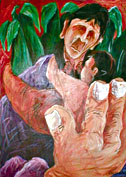|

Comment
on this story
What:
Native Traditions, art by Antuco Chicaiza
Where:
Tomato Head, Market Square
When:
Through Aug. 4
|
|

Native Tradition provokes more than a few questions
by Heather Joyner
Prior to seeing Antuco Chicaiza's paintings and drawings at the Tomato Head, I was summoned to traffic court up the hill from the Civic Coliseum. Early in the proceedings, a Hispanic woman approached the police sergeant (who stood reading out names) and attempted to clarify the presence of someone she'd brought along. She was presumably there to translate for the recipient of the citation, and she had an accent; no matter what she said in English, the sergeant twisted his face in confusion. Given his inability to understand her words, she retreated to the rear of the courtroom. There she sat with her bewildered and tired-looking companions during the two hours and 10 minutes I waited to be called forward, and there she sat when I left the almost-empty room. I couldn't help but wonder what determined the pecking order of the more than 40 people allowed to address the judge or why we had to wait patiently as others were let go. Maybe it just happened that way, but the Hispanic woman's look of defeat and isolation was still with me as I made my way to Market Square.
As for the work of the artist Chicaiza, I couldn't help but wonder in my post-court state of mind what it seeks to express. His images of Native—possibly Chilean—Americans in various configurations, collectively titled Native Traditions, project cultural isolation (apparently prevalent even in Knoxville) and establish separation between "them" and "us," whoever "us" is. Furthermore, Chicaiza's people have no eyes. However worn the metaphor, I'll say that it's as if blinds for windows to the soul have been drawn, leaving us no clue as to what's going on inside. We can take in numerous faces that all look alike and decide they're meant to be iconic, but for what reason? Does Chicaiza wish to carry on a tradition of symbolic representation? To comment upon how one ethnic group might view another? To create unity among images in order to form an indivisible whole?
Ten pieces in color and four charcoal drawings are graphically striking and reveal impressive technical skill. The shapes of Chicaiza's stylized women are lyrical, and his composition is intuitively balanced. Nevertheless, Chicaiza's oft-used "squiggles" merely suggest spontaneity, and like the figures they surround, they seem more about effect than anything else. What is implied overshadows whatever might be inherent, and the process of creation has seemingly dumped discovery for the sake of certain outcome. I'm possibly too harsh with my opinions, and being mine, they're no doubt limited. But Chicaiza's failure to move me makes me want to scream. I want to understand what his emphasis on hands (some capable, some defensive) means, and why Navajo-looking ceramics are somehow equated with the people they accompany. Are his humans meant to be perceived as objects, or do they imbue their possessions with human spirit? It's as frustrating as attending a lecture in German and catching only bits and pieces.
Chicaiza's drawings, being harder-edged and less "lovely" than his color pastels, feel more in tune with their subject matter. That is, if their focus is indeed one of conflict or contrast. As for two large paintings dominating the Tomato Head's east wall, their "distressed" raw wood frames (appearing burned or otherwise damaged) remind me of something Coco Chanel supposedly said regarding fashion. If one notices that a woman looks good without noticing how her clothing itself looks, she's achieved true style. Call me conservative, but I prefer frames that subtly augment rather than compete with the art they contain.
Then there's that word "style." Can an artist have "a style" and not be ruled by it? Does it seem forced or inevitable? However distinctive Chicaiza's combination of line, form, and color is, if it doesn't ring true or connect on an emotional level with its imagery, we're lost. Perhaps I'm like the perplexed sergeant who cannot hear what's being said because the words sound different. If so, I apologize sincerely and profusely—in particular to Chicaiza, whose bold color and fearless execution may simply be beyond me. If nothing else, the current show has challenged my thinking and might very well challenge yours.

July 26, 2001 * Vol. 11, No. 30
© 2001 Metro Pulse
|